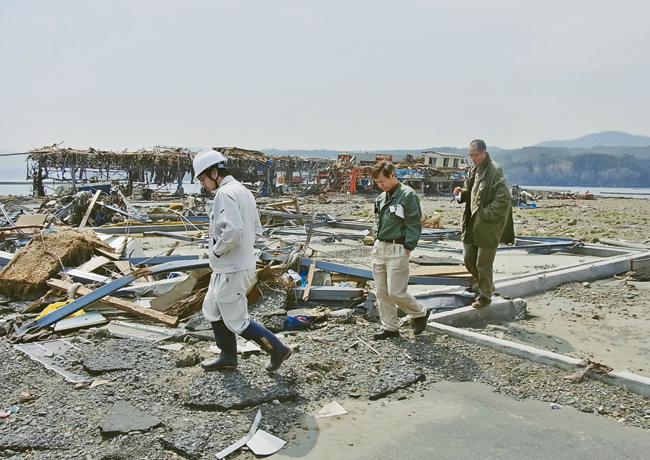
One year after the catastrophic earthquake and tsunami, Japan is making progress toward rebuilding its devastated east coast, assisted by local architects and construction professionals eager to help—but there is still a long way to go.
On March 11, 2011, a 9.0-magnitude earthquake struck Japan’s eastern Sanriku coast, triggering an enormous tidal wave that left 310,000 people homeless, 23,000 dead or missing, and a cluster of unstable nuclear reactors. Today the debris is largely cleared, roads are open, railways are back in operation, and more than half of the damaged seaports are functioning again. And there is more good news. All of the evacuation centers are closed, thanks to the completion of temporary housing throughout the blighted region.
After the quake, many architects were quick to get involved. Just eight days later Hitoshi Abe launched ArchiAid, a network intended to support a range of reconstruction activities. And early on a group of five Tokyo architects—Hiroshi Naito, Toyo Ito, SANAA’s Kazuyo Sejima, Kengo Kuma, and Riken Yamamoto—formed KISYN-no-kai in an effort to contribute their skills to the rebuilding. But with reconstruction plans moving at a snail’s pace and planning matters delegated to civil engineers (as Japan is wont to do), these groups are turning their attention to small interventions and community-centered activities.
Myriad temporary housing developments, funded entirely by the central government, occupy schoolyards, baseball diamonds, and any other usable land. Built at the discretion of individual municipalities by local contractors, the housing projects are intended for two-year occupancy. This short term excuses the projects from the usual building codes. Yet realistically, it will take a lot longer than two years to put a permanent solution in place.
To qualify for funding, projects must comply with government standards, such as a 323-square-foot size limit. But these developments vary in quality, often requiring custom interventions to make them tolerable. To help, volunteer architects and students are boosting comfort levels by building benches, installing shelving, and taping insulating plastic sheets on windows. “It’s not glamorous or ‘design,’ but the impact on people’s lives is enormous,” says Liz Maly, a doctoral student researching global-disaster-relief housing at Kobe University.
Stopgap construction fixes, however, cannot resolve the endemic social issues. Since few of the afflicted communities were able to move en masse into a single development, residents were wrenched not just from their homes but from their support networks as well.
Doing what they can to offset the deficits, architects are designing small buildings that they, and the community, can erect quickly, without equipment or skilled labor—both in short supply. “This is the first time many architects are actually building,” says Shigeru Ban. “They are always leading groups, but if there are too many leaders, nothing moves.” Still, the question of permanent solutions—a 10-year process as anticipated by the Prime Minister’s Reconstruction Headquarters—looms large. And while architects are engaged in the discussion, their role is yet to be determined and the process is slow.
One problem is where to rebuild. Because of the tsunami, and a threat of future tidal waves, the in situ reconstruction typical after an earthquake is risky at best and impossible where the water level has risen for good. But flat land is limited and leveling mountains is expensive, even for the government, which has allocated 18 trillion yen (about $232 billion at the time of publication) for reconstruction, according to the Nihon Keizai Shimbun, a leading economics newspaper.
Another issue is what to rebuild. “[Local residents] want to recover what they had before, but even then half of the shopping areas were closed,” says Abe, a Sendai architect and chair of Architecture and Urban Design at UCLA. The consolidation of shrinking towns was already being considered for the region, which had been affected by depopulation and an aging citizenry prior to the disaster. And in Fukushima Prefecture (home of the Daiichi nuclear debacle) actual damage was modest, but no one really knows when it will be safe for residents, mainly farmers, to return.
People |
Products |

Post a comment to this article
Report Abusive Comment